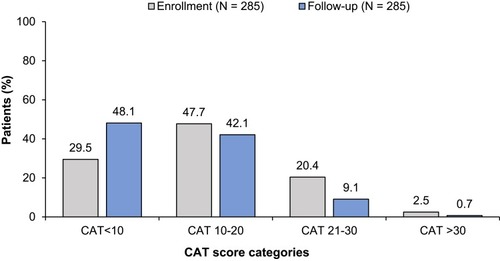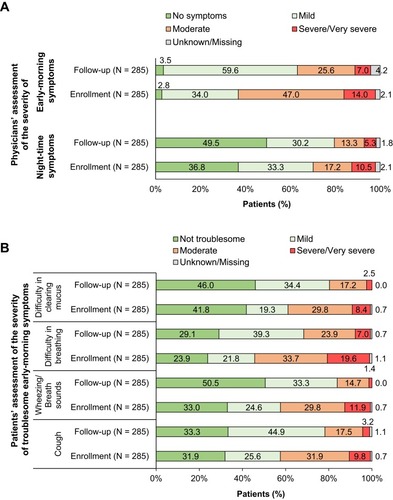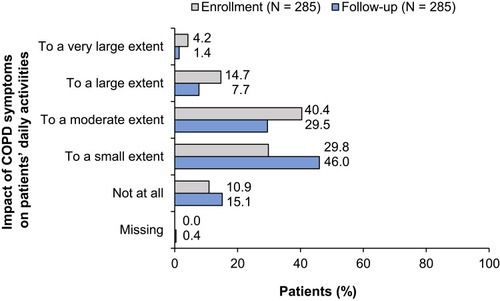Figures & data
Table 1 Patient and Disease Characteristics at Enrollment
Table 2 Prior and Concomitant Medications for COPD Management
Figure 1 Chronic obstructive pulmonary disease assessment test (CAT) scores at enrollment and at the 12-week follow-up visit. Patient distribution in different categories according to their CAT scores at enrollment (dark grey bars) and at the follow-up visit (light grey bars) is displayed. The numbers above bars indicate the percentage of patients in each CAT score category, as indicated in the x-axis.

Figure 2 Severity of early-morning and night-time symptoms at enrollment and at the 12-week follow-up visit. (A) Patient distribution according to the physician-assessed severity of early-morning and night-time symptoms at enrollment and at the follow-up visit. Numbers indicate the percentages of patients. (B) Patient distribution according to the severity of troublesome early-morning symptoms as perceived by the patients at enrollment and at the follow-up visit. Numbers indicate the percentages of patients.

Figure 3 Patient distribution according to the impact of chronic obstructive pulmonary disease symptoms on the patients’ daily activities at enrollment (dark grey bars) and at the 12-week follow-up visit (light grey bars).

Table 3 Evaluation of the Features of the Aclidinium Bromide Inhaler According to the Physicians and the Patients
Figure 4 Multivariable regression analyses of the association of patient and disease characteristics with achievement of the minimum clinically important difference (MCID) in the total chronic obstructive pulmonary disease (COPD) assessment test (CAT) score from enrollment to the 12-week follow-up visit. The final multivariable logistic model (based on minimization of Akaike information criterion) included the following factors: obesity [body mass index (BMI) ≥30 kg/m2], smoking status, newly-diagnosed COPD, CAT score at enrollment, no prior treatment with long-acting muscarinic antagonists (LAMA), at least moderate early-morning and/or night-time symptoms. Bold values indicate statistical significance.
![Figure 4 Multivariable regression analyses of the association of patient and disease characteristics with achievement of the minimum clinically important difference (MCID) in the total chronic obstructive pulmonary disease (COPD) assessment test (CAT) score from enrollment to the 12-week follow-up visit. The final multivariable logistic model (based on minimization of Akaike information criterion) included the following factors: obesity [body mass index (BMI) ≥30 kg/m2], smoking status, newly-diagnosed COPD, CAT score at enrollment, no prior treatment with long-acting muscarinic antagonists (LAMA), at least moderate early-morning and/or night-time symptoms. Bold values indicate statistical significance.](/cms/asset/8eb38af5-8421-4dbd-9415-92503a1d4fbe/dcop_a_12198164_f0004_c.jpg)
